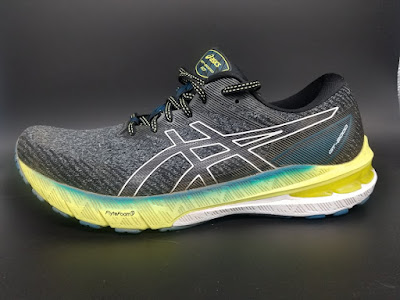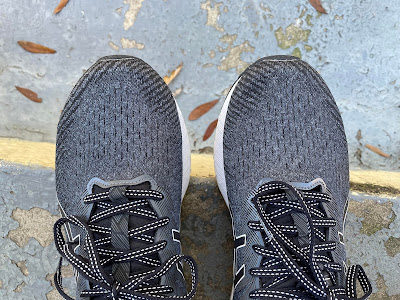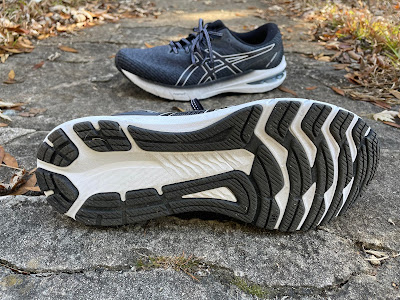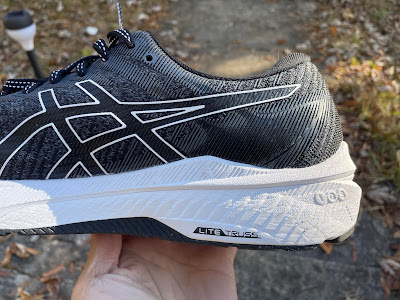ASICS GT-2000 10 Multiple Tester Review
By Chief Editor Matt Klein and Contributor David Salas
The ASICS GT-2000 has been a relatively popular line from ASICS that provides a reliable and consistent ride that doesn't break the budget. The shoe is a light stability trainer for running that also has a little bit of crossover into walking and weekend warrior type activities. New features for the 10th edition include using LITE TRUSS that utilizes outsole design and geometry of the shoe to help provide stability instead of posting or plastic arches.
$129 at Running Warehouse
Weight: 9.9 oz / 280 g (men's size 9) 8.4 oz / 238 g (women's size 8)
Stack Height: 27 mm / 19 mm
Drop: 8 mm drop
Classification: Mild Stability Daily Training Shoe
 |
| Medial side of the Asics GT-2000 10. "Lite Truss" system thinly seen at botom along heel to midfoot, with denser white foam surrounding it. |
 |
| Asics GT-2000 10, lateral view. A black upper with a mixed yellow and white midsole with a streak of a turquise at the top. |
Matt: The ASICS GT-2000 10 is a light stability shoe with a flexible forefoot, mild stability from a new LITE TRUSS, fairly normal fit and a lightweight feel. This version of the GT-2000 series features a massive overhaul with the removal of the midfoot plastic trusstic, a full ground contact outsole, a new knit upper, and a slightly lower drop (8 mm). Fans of the series will find a ride that is traditional in many ways, but evolved in others.
David: The ASICS GT-2000 10 is a light stability training shoe that provides a relatively firm but protective and consistent ride throughout. The shoe has a very traditional trainer feel to it while having some added stability with the LITE TRUSSIC. The upper is pretty comfortable throughout and this shoe does a pretty good job of providing solid value for the low price point.
FIT (LENGTH / WIDTH / COMFORT)
Matt: The ASICS GT 2000 10 fits me true to size in my normal US men's size 10. The upper is a full knit with additional overlays. The knit mesh is somewhat flexible, but combined with the overlays keeps the foot very secure. The width is fairly normal throughout the length of the shoe, with some gentle stretch if needed in the forefoot. The heel is slightly snug, which adds a little extra security. There is a significant heel counter in the rearfoot as usual, although it is slightly less dense than previous models. It is still plenty secure and there is plenty of cushioning around the heel collar for those that are sensitive to them (those that are very sensitive may have some mild issues still however). The areas of the heel right under the medial and lateral ankle bones (malleoli) sit fairly low. I was surprised at this and almost had to lace lock the upper. However the heel counter and solid lacing kept me locked in.
The tongue is perfectly padded but does sometimes slide very slightly as it is free floating except for a lock in from the laces. This is not a shoe I would use sockless as despite the knit being very comfortable, I could feel the logo overlays on my midfoot. The toe guard is very mild and flexible, but this is a shoe that I would suggest using socks for. Overall the upper is quite comfortable with the knit material and fairly normal fit, albeit with solid subtle security.
David: The GT-2000 10 fits true to size in my normal 9.5.. The upper overall is pretty comfortable throughout with a knit mesh like material that feels like a thick sock throughout. The width throughout the heel, midfoot, and forefoot are all normal and not overly narrow or wide in any region. There is a heel counter present in the heel that sits like a cup for the calcaneus that is lightly padded throughout and gave no irritation. There are minimal overlays outside of the ASICS logo medially and laterally. I had a small amount of translation in the medial rearfoot/midfoot transition but this seemed to fix when lacing down the shoe a little bit tighter. The tongue is nicely padded and is normal depth for a daily training shoe. Overall the dimensions of the shoe are constructed quite nicely and provides a nice cozy hold throughout that I would not have for either long miles or even walking around throughout the day.
PERFORMANCE (RIDE / SPEED)
Matt: The ASICS GT-2000 10 provides a traditional ASICS transition in the rearfoot and a smooth ride from the heel to toe off. There is a small bevel at the posterior lateral heel, which combined with the gel provides a slightly better transition from heel strike forward. If you are used to larger heel bevels, there may be a transition period required as the midsole and gel break in to compress better. There is no plastic trusstic system in this version and with the full ground contact outsole, the ride is very smooth through the midfoot. The forefoot has several flex grooves, which combined with the softer Flytefoam propel makes for a very flexible toe off. The heel drop is now 8mm which improves the rearfoot transition. The midsole feels slightly firmer in the rearfoot and slightly soft in the forefoot.
This is a more traditional shoe in regards to stack height, so the forefoot has some decent ground feel. The overall ride is fairly relaxed. The amount of flexibility at the forefoot combined with the stable and cushioned ride at the heel make this shoe best for easy runs, recovery runs and general mileage. I have attempted to workouts in this shoe, but there are so many better options for speed. It can be used for more relaxed workouts like strides, short hill repeats and fartleks, but for anything faster other shoes may be worth considering. Durability wise the GT-2000 is great. I have 46 miles on my pair and see no wear on the outsole. I have not taken these on technical trails, but the smooth outsole works best on road and smooth dirt. Overall the ride is relaxed and consistent.
David: The ASICS GT 2000-10 provides a relatively smooth and consistent ride throughout from heel to toe. In a lot of ways this feels like a traditional neutral trainer with some light added stability elements. The outsole cuts into the midsole a little bit medially to give some added rigidity and this can be felt a little bit in the ride of the shoe. The platform is also pretty wide through the midfoot and also feels nice and stable through the transition point. There are also some sidewalls in the midsole at the distal rearfoot that seem to help a little bit with guidance, though I still had some translation in the region with the upper. The midsole feels like a very traditional EVA and the heel has a slight bevel with GEL cushioning to absorb some of the load at initial contact. Though the ride has some firmness and rigidity through the midfoot, the forefoot has decent flexibility since it uses flex grooves throughout the entire duration of the forefoot. For the most part the ride really isn't anything flashy, but it isn't designed to be. The ride is a pleasant, slightly firm riding, consistent ride. It also seems that there is a dual midsole throughout. The upper part of the rearfoot and midfoot acts almost as a topsole and then becomes the full midsole in the forefoot which also softens up the forefoot more as well.
STABILITY
Matt: The GT-2000 10 is a stability shoe, although some changes have made it more on the light stability side of things. The shoe is stable throughout, but the methods used have changed compared to previous versions. The LITE TRUSS provides some medial resistance in the heel and midfoot. I notice I feel it more the harder I land. There are also mild guiderails at the heel, with small elevations of the midsole coming up around the foot at the anterior heel and posterior midfoot. This is another way to provide gentle guidance in this area. The lack of a trusstic system in the midfoot but the full ground contact outsole provides a smooth and stable transition forward, albeit less stiff and snappy than previous versions. Finally, the forefoot has a high level of flexibility moving in the sagittal plane (forwards and backwards) with mild sole flare on both sides. The changes make the GT-2000 10 more naturally stable, providing light but consistent stability throughout the length of the shoe.
David: Overall the stability of the GT-2000 10 provides pretty good stability throughout. The outsole provides a nice wide platform to land on and propel from and gives a nice stable feel throughout. The shoe also has relative rigidity through the rearfoot and midfoot to keep the shoe from deforming to outside forces or surfaces. The LITE TRUSS also does a pretty good job of improving rigidity without posting by utilizing the outsole and rubber as part of the stability design along the medial aspect of the shoe. The upper is comfortable but could be better reinforced. I did have some medial translation through the rearfoot when taking some turns or running in off road conditions. Overall stability is done pretty well though however.
 |
| Up close on the heel of the GT-2000 10. "GT-2000" seen written on heel. Gel seen in the heel's foam. |
David: ASICS has been doing a great deal with shoe geometry and creating new means of providing stability in shoes over the last year. What they do with the LITE TRUSSIC system is quite interesting and innovative. Instead of using a hard plastic through the midfoot or posting the foam, the shoe utilizes its own geometry and outsole pattern to create some stability. The platform is widened throughout and the outsole is extended toward the midline of the shoe and raises up into the midsole itself. In some ways this creates some rigidity and also a post like effect without actually using a post. The shoe also utilizes a dual density midsole it appears with a topsole in the rearfoot and midfoot and a firmer midsole through those regions. Using this design the foam compresses less upon load and helps follow the natural path of the foot and shoe a little easier. This also does not jeopardize the ride of the shoe making it overly rigid because the midsole changes to be softer and more flexible in the forefoot. Overall they did a great job of providing good stability, especially at the price point of the GT-2000.
Matt: The biggest change in the GT-2000 10 is the removal of the midfoot trusstic system. This dramatically changes the ride, creating a smoother transition through the midfoot. Fortunately, ASICS made the outsole full ground contact. This not improves the transition but also ensures that there is not a flex point in the midfoot. This is something I have discussed endlessly with the use of trusstic or other stiffening systems used in shoes that do not have midfoot contact. The elevated midfoot, even with a stiffening agent, will eventually create a flex point there. This is not optimal at there are no joints in that allow motion in that direction at the midfoot. During the stance phase of gait where the body is transitioning over the midfoot, all forward motion is coming from the tibia bone translating forward through the ANKLE joint. The midfoot joints meanwhile may be collapsing and moving medially (inwards) as the individual pronates (or at least... they should) to facilitate shock absorption. Some people need varying degrees of assistance here if they are not conditioned enough to appropriately control pronation. Hence why posting, wedges and other methods of stability are commonly used here. All parts of a shoe wear out. The trusstic systems and any stiffening agent will eventually start to loosen. If they are over a split outsole design at the midfoot, then guess where there is going to be more motion?
I am not against midfoot trusstics. They do a great job of stiffening an area, they just need to do in appropriately. A better method if ASICS wants to maintain the GT-2000 series as moderate stability would be to keep the trusstic system but make sure to maintain the full ground contact outsole. IE embed the trusstic deeper in the midsole while maintaining full ground contact. These two components together will greatly stiffen the midfoot, potentially too much for some people, so this would have to be optimized. Right now, the lack of a trusstic system means the ASICS GT-2000 10 has a more mild stability design. This is NOT a bad thing and the LITE TRUSS is still evident. The use of full ground contact, the small side walls and other methods means ASICS is just moving toward more naturally stable designs. I am interested to see how consumers react to this, so please email us if you buy the shoe and let us know how they feel to you if you have been a long time GT-2000 wearer.
RECOMMENDATIONS
Matt: The changes in the ASICS GT-2000 10 are drastic, but interesting. These are bold moves for a company that was previously more "old-school" in thinking. We have seen though through 2020 and 2021 that ASICS is making some aggressive moves and jumps forward in regards to stability and other technologies. This is very good and while I really like the GT-2000 10 as I like more mild stability shoes, there needs to be a careful transition forward with popular shoes like this to not lose customers. The shoe has a smooth transition, but I might suggest adding a bit more stiffness back into the midfoot for those transitioning from prior versions of the GT-2000 10. This may also provide a bit more stability if not overdone.
For other ways to compensate for the mild decrease in stability, I would suggest playing with additional non-traditional ways to add stability. The heel counter can be extended on the medial side a bit more. The mild elevated medial and lateral aspects of the midsole could be moved a bit higher to provide a little more guidance. There are many options now that ASICS can use to keep this at a more moderate stability level. Or they can keep it where it is as a light stability shoe. I just need to be clear that there is a great deal of personal bias there as I again like this shoe category.
David: I was pretty happy with the GT-2000 10. I like how they integrated stability with the shoe, but I do think the upper could be a little bit more refined through the medial aspect of the shoe to help prevent any translation through the rearfoot or midfoot. The heel counter is done pretty well but I do think there could be a liner that extends through the medial aspect of the shoe to just give this region a little bit more structure. Because of the cozy and flexible nature of the upper I had some translation in this region and a real low riding guide rail like liner could do the trick.
WHO THIS SHOE IS FOR (Conclusion)
Matt: The ASICS GT-2000 10 is for those looking for a mild stability shoe with a comfortable knit upper and comfortable/relaxed ride for daily runs and getting mileage in. While the GT-2000 10 has many components that make it more traditional, like the normal stack height and the use of a medial support system like the LITE TRUSS, there are many more things that make it very progressive. The full ground contact outsole, mild sidewalls and knit upper provide a smooth transition and mildly customized fit that should work well for a variety of people. While this shoe is different from the previous versions, those needing mild to moderate stability will still find the ASICS GT-2000 10 a dependable shoe for those with normal width feet wanting a shoe they can trust for getting their miles in.
David: The ASICS GT-2000 is for someone looking for a light stability training shoe that will not break the bank and can overlap with some normal daily activities. In some ways this is a solid daily training options but also can dabble in multi sport or weekend warrior type usage. The ride of the shoe is protective but does ride relatively firm throughout. The wide platform does provide a nice stable base and I think a lot of people will like this. The shoe itself is nothing overly fancy or flashy but it is consistent and reliable.
GRADING (SHOE CATEGORY)
Matt
Fit: B+ (Comfortable knit upper with decent security. Could have smoother internal mesh and could be just a touch wider in the forefoot)
Performance: B (Smooth ride that stays consistent, but fairly flat midsole that does not have much responsiveness. Best for easy mileage)
Stability: A- (Light Stability shoe with additional methods. New full ground contact outsole improves Midfoot stability)
DPT/Footwear Science: A- (Good use of more progressive stability methods. May need a bit more in the midfoot for those with moderate stability needs.)
Personal: B- (A good consistent shoe, but it is on the unresponsiveness side for my personal taste)
Overall: B+ (Nice to have something in the light stability category at a good price. Stable ride with knit upper that is consistent for those wanting to get their miles in)
David
Fit: A- (Very comfortable upper with good dimensions throughout, I do think medial rearfoot/midfoot security could be improved)
Performance: B (Consistent and stable ride throughout and gives a very familiar trainer feel to it. Nothing flashy or fancy or crazy responsive.)
Stability: A- (Overall stability is done pretty well throughout with wide base and LITE TRUSSIC. Upper security in medial rearfoot/midfoot could be improved)
DPT/Footwear Science: A (I think ASICS did a great job of using innovation and already present materials in the shoe to create smooth stability throughout the rearfoot and midfoot)
Personal: B (I think there is a lot of bang for buck in this shoe but the ride can come off a little flat with responsiveness, it is a nice consistent option though)
Overall: B+/A- (A solid option to add the light stability category, especially for those balling on a budget. Consistent and stable ride with a nice comfortable upper)
SHOP | SUPPORT DOR
Find the ASICS GT-2000 10 at Running Warehouse here. Using the link to purchase helps support Doctors of Running. Thanks so much!
Shop Gear We Love
Spring Energy Gels: https://bit.ly/3k3nof8
Huma Energy Gels: https://bit.ly/3xVMjGj
BOA Shorts: https://bit.ly/37UDcLC
Saucony Endorphin Speed 2: https://bit.ly/3sulS9O
Feetures Socks: https://bit.ly/3hOwT1S
Theragun Massager: https://bit.ly/36OEU0s
FURTHER READING
Visit our Guide to Stability Shoes page for similar shoes, tips, and guidance on the genre.
Recently at Doctors of Running
Ankle Sprain 101: Basics, Rehab, and More | Podcast Episode 54
Skechers MaxRoad 5 Review - A new H-Plate and upper headlines this excellent update to the MaxRoad series
2021 Summer Split Shorts Review
New Balance Fresh Foam X Vongo v5 Review - Impressive upper and medial post on soft, but stable Fresh Foam
Skechers Speed Freek Review - Visit Skecher's latest marathon racer
Thanks for reading!
Strava: Doctors of Running
Podcast: Virtual Roundtable
Pinterest: Doctors of Running
TESTER PROFILES:
Doctor of Physical Therapy
Dr. David Salas is a 135 lb male with notable PRs ranging from 3:54 in the 1500m to 1:08:36 for half marathon. He typically runs 60 to 70 miles per week and trains from about 7:30 recovery runs to fast shorter efforts at 4:30 pace. He normally prefers neutral shoes with a firmer ride, but is completely open to other types of shoes. He is a footwear enthusiast at heart and will always appreciate a high quality shoe when it comes around. For updates on training or testing,
Editor's Note: As always, the views presented on this website belong to myself or the selected few who contribute to these posts. This website should not and does not serve as a replacement for seeking medical care. If you are currently injured or concerned about an injury, please see your local running physical therapist. If you are in the Los Angeles area, I am currently taking clients for running evaluations.
Contact us at doctorsofrunning@gmail.com
NEXT: Deckers X Lab NVRSTP Pack Review

















